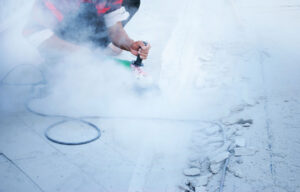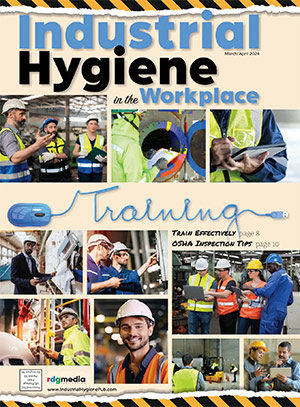The “New Asbestos:” Protect Workers from Silica Dust
By: Tim Turney, Contributor
 In terms of public perception of health and safety hazards in the workplace, few are as well-known as the risks associated with asbestos. Until the 1970s, asbestos was a word synonymous with safety. The mineral was used in the automobile, construction, power and chemical sectors, among others, as part of the industries’ fireproofing measures.
In terms of public perception of health and safety hazards in the workplace, few are as well-known as the risks associated with asbestos. Until the 1970s, asbestos was a word synonymous with safety. The mineral was used in the automobile, construction, power and chemical sectors, among others, as part of the industries’ fireproofing measures.
But, once legislation was implemented to control asbestos exposure and word spread about the severe health effects it can cause, asbestos became one of the most high-profile health and safety considerations worldwide. Just as perceptions of asbestos shifted as its impacts on health came to light, we are now seeing a similar shift regarding a substance that many are hailing as “the next asbestos”—crystalline silica.
Crystalline Silica’s Dangers
OSHA estimates that 2.3 million workers are exposed to silica dust every year. Silica is found in varying amounts in most rocks, sand and clay, and is a major constituent in construction materials made from these resources—including bricks, tiles and concrete. Workers can breathe in silica dust while cutting, sawing, drilling or crushing materials.
Silica has a crystalline form, occurring naturally in varying amounts in any substance containing silica, that poses potential health concerns. Crystalline silica can damage tissue in the lungs and lead to lung disease, chronic obstructive pulmonary disease or incurable silicosis.
As with any known workplace health risk, a correctly implemented scheme of controls using the hierarchy of controls is the most effective means of reducing worker exposure to respirable crystalline silica. This can help reduce both the likelihood of workers developing health complications, such as silicosis, and the potential legal ramifications for employers.
Measures include a correctly executed program of air monitoring, which can include both monitoring at the site level and on an individual employee level using personal sampling pumps. Air monitoring can quantify exposure levels or, if controls are in place, check that they are effective and measure any residual risk.
 In Control
In Control
Businesses can measure worker exposure using personal sampling pumps. However, it is important that the pumps are used with the correct sampling head and, in the case of respirable dust, a cyclone and filter, which collects the particulate.
Once the sample is analyzed by a laboratory, the level of exposure can be calculated. Action can then be taken to improve control measures to ensure exposure is reduced to as low as is practicably possible. Improvements have been made to different elements of personal sampling pumps over time.
Battery technology, back pressure capability, accurate flow control, minimized pulsation, data download and the ability to be intrinsically safe have all been improved, ensuring measurement of an individual’s exposure to harmful substances is as accurate as possible. Understanding the factors in which the personal sampling pump needs to operate effectively will allow employers to choose the most effective device suited to their working environment.
Correct implementation of personal sampling relies on a thorough understanding of practice, procedure, how sampling pumps function, and use of the correct sampling head and filters.
Correct Equipment, Calibrated Properly
Personal sampling pumps must adhere to the standard ISO 13137:2013. The standard sets limits for required flow stability and maximum permissible pulsation levels, enabling users of personal air sampling pumps to adopt a consistent approach for flow-rate assessment.
The standard provides a comprehensive framework that specifies test methods to determine performance of air sampling pumps and ensures that environmental influences, such as air pressure and temperature, have a minimal impact on the accuracy of the sampled air—which, in turn, could affect sample results.
Correct equipment—calibrated properly—and an awareness of the limitations and impact on data collection that the equipment itself can have should be at the forefront of correct air monitoring procedures, as well as the fight against “the new asbestos.” Pumps, including the Apex2, that operate with a pulsation value of less than 10% and conform to all relevant ISO standards, give industrial hygienists and site managers the peace of mind that data captured is reliable and unaffected by pump pulsation. Low pulsations is particularly important when sampling for crystalline silica, as the sampling head is a cyclone, and only at low pulsation levels will it get the correct “respirable” sample.
While awareness of silica’s negative health effects is on the rise, correct procedure, safety-focused culture and the right equipment will ensure that the downward trend in silicosis mortality continues.
Bridging the Gap
Employee health must remain a priority and a core component of any workplace health and safety management system. Likewise, monitoring must continue to evolve in accordance with changing production methods, and the industry is already moving in a positive direction.
In addition, education and training that raises workers’ awareness of the risks of dust exposure are integral in ensuring that they understand how to prioritize and protect their health.
Tim Turney is Global Marketing Manager at Casella and graduated as an engineer from Queen Mary and Westfield in London. Since starting at Casella in 1998, Tim has been involved in the acoustics and air sampling industry, specializing in measurement and instrumentation technologies. For more information about air sampling, monitoring and calibration solutions, visit www.casellasolutions.com
Share on Socials!
Hearing Loss Prevention Protects More than Hearing
ANSI/ISEA Z89.1-2014: Head Protection Guidelines
For Safety’s Sake: Managing Industrial Dust and Fumes
Leaders in Industrial Hygiene
Council for Accreditation in Occupational Hearing Conservation (CAOHC)
Subscribe!
Sign up to receive our industry publications for FREE!









